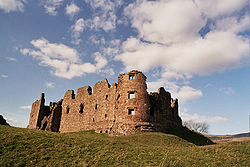Brough, Westmorland
| Brough | |
| Westmorland | |
|---|---|
 Brough Castle from the southeast | |
| Location | |
| Grid reference: | NY794145 |
| Location: | 54°31’32"N, 2°19’8"W |
| Data | |
| Population: | 680 (2001) |
| Post town: | Kirkby Stephen |
| Postcode: | CA17 |
| Dialling code: | 017683 |
| Local Government | |
| Council: | Westmorland & Furness |
| Parliamentary constituency: |
Penrith and the Border |
Brough, sometimes known as Brough under Stainmore, is a village in Westmorland, on the western fringe of the Pennines near Stainmore. At the 2001 census it had a population of 680.
The village is on the A66 trans-Pennine road, and the Swindale Beck, about 8 miles southeast of Appleby-in-Westmorland and 5 miles northeast of Kirkby Stephen.

The village is on the site of the Roman fort of Verterae, or Verteris, on the Roman road linking Carlisle with Ermine Street. The area of the rectangular fort, which once occupied the land to the south of the Swindale Beck, is now a Scheduled Ancient Monument.[1] Brough Castle was built in the 11th century within the northern part of the former fort.
Brough has historically been divided into Market Brough, to the north, and Church Brough, to the south and centred on the castle and St Michael's Church, with the Swindale Beck running between them. In 1977 this division was made indisputably physical by the construction of the Brough bypass dual carriageway, taking the A66 away from the village main street.

St Michael's Church dates from the Norman period, and may have suffered during an attack by King William I of Scotland in 1174. The church was enlarged in the 14th century, and in the early 16th century when most of the existing structure was built. The tower was constructed by Thomas Blenkinsop of Helbeck in 1513. Repairs and improvements continue to this day.
Nearby is Augill Castle, built in 1841 by John Bagot Pearson from Kirkby Lonsdale as a weekend retreat and now a hotel.
Traditionally, on Twelfth Night, a burning holly tree (subsequently, ash trees were used) would be carried through the village, followed by a brass band. When the flames had partially gone out, the villagers would try to bring the tree to a pub, where the party would continue until the early hours of the morning.[2] The village was also the venue for a popular fair on the second Thursday of March.

References
- ↑ National Heritage List 1007148: Brough Castle and Brough (Verteris) Roman fort and civil settlement
- ↑ "Holly Night at Brough" from The Every-day Book and Table Book; or, Everlasting Calendar of Popular Amusements, Sports, Pastimes, Ceremonies, Manners, Customs, and Events, Each of the Three Hundred and Sixty-Five Days, in Past and Present Times; Forming a Complete History of the Year, Months, and Seasons, and a Perpetual Key to the Almanac, Including Accounts of the Weather, Rules for Health and Conduct, Remarkable and Important Anecdotes, Facts, and Notices, in Chronology, Antiquities, Topography, Biography, Natural History, Art, Science, and General Literature; Derived from the Most Authentic Sources, and Valuable Original Communication, with Poetical Elucidations, for Daily Use and Diversion. Vol III., ed. William Hone, (London: 1838) p 26-27